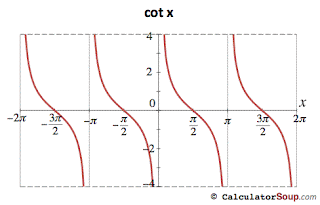Inverse Trigonometric Functions
As learned in previous chapters, functions can only have inverses if they are one to one, if each of their x values have only one y value and each y value has only one x value. Obviously, sine, cosine and tangent functions are not one to one, as their graphs all fail the horizontal line test miserably.
SINE
COSINE
TANGENT
But these functions do have inverses.
How? By setting a very small domain for each function that allows each function to become one to one.
As you can see from the picture below, in this small chunk of the graph, this sine function is one to one.
This is because its domain is [-π/2, π/2].
To have an inverse:
Sine:
Domain:[-π/2, π/2]
Range: [-1, 1]
Because the inverse flips the domain and range:
-Sine:
Domain: [-1, 1]
Range: [-π/2, π/2]
The cosine function has a different domain than the sine function
To have an inverse:
Cosine:
Domain: [0, π]
Range: [-1,1]
And again:
-Cosine:
Domain; [-1, 1]
Range: [0, π]
The tangent function is easier than the sine and cosine functions, as it is just one period of the graph.
To have an inverse:
Tangent:
Domain: [-π/2, π/2]
Range: [-∞, ∞]
Other Things to Remember:
-The output of an inverse trig function is ALWAYS an angle.
All Inverse functions posses the properties:
f[ƒ−1(x)] = x and ƒ−1[f(x)] = x
These properties are also used with inverse trig functions
If -1 ≤ x ≤ 1 and (π/2)≤ y ≤ π, then
sin(-sin x) =x and –sin(sin y) =y
If -1 ≤ x ≤1 and 0 ≤ y ≤ π, then
cos(-cos x) = x and –cos(cos y) =y
If x is a real number and (–π/2)< y < π/2, then
tan(-tan x) =x and –tan(tan y) = y
Remember that these properties do not apply for values outside of the intervals given. For instance:
-sin[sin (3 π/2)] = -sin(-1) = - π/2 not 3 π/2
You can also use these properties to re-write a trig function without using trig values. For instance,
sin(-cosx)
-cos x= Θ
x = cos Θ
Adj. = x
Hyp. = 1
= Opp.














